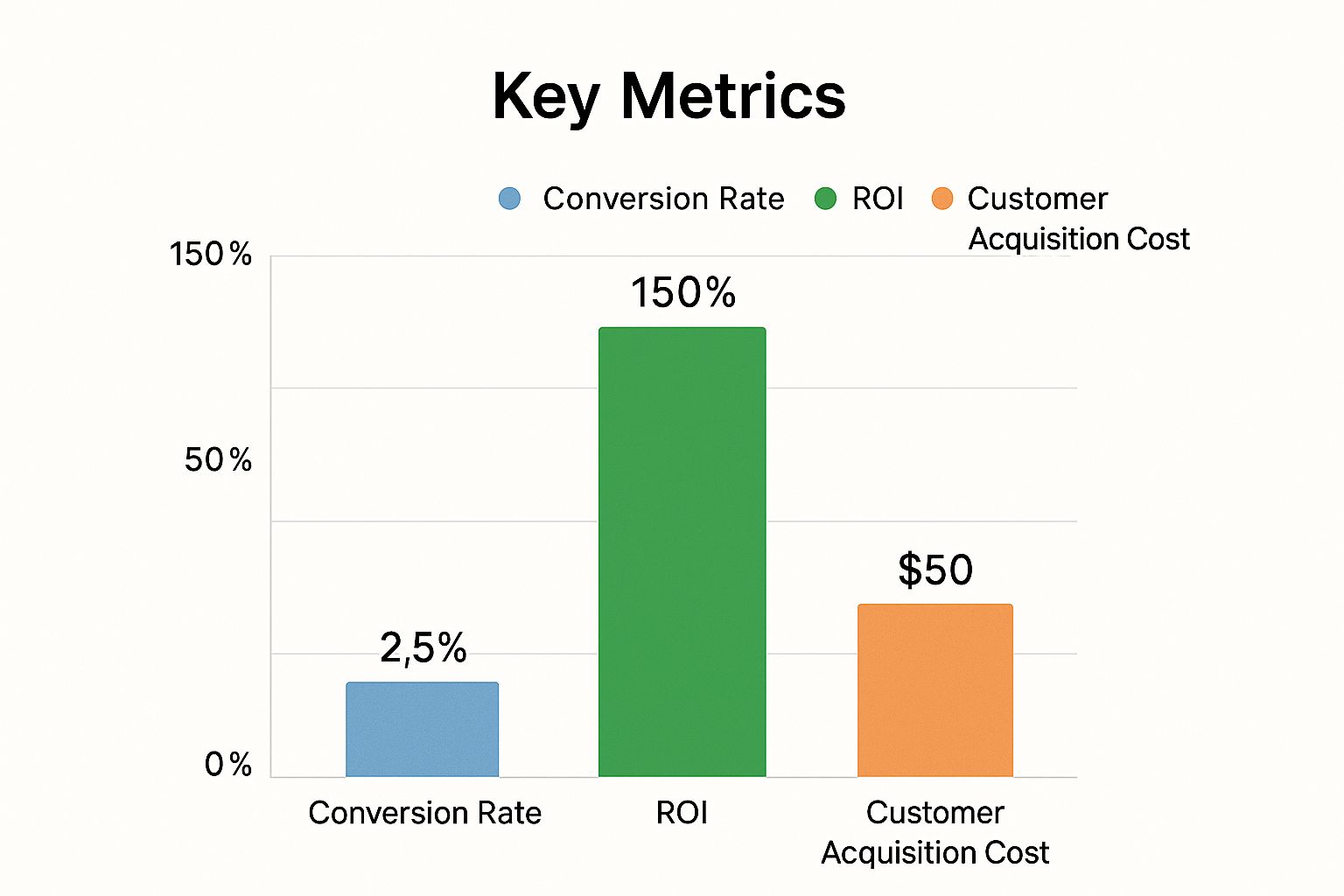How to Measure Marketing Effectiveness for Growth
August 2, 2025

As a B2B SaaS founder, you're constantly asked to justify every dollar. But how do you prove your marketing is actually working?
It's time to move past surface-level wins. Likes, shares, and high impression counts feel good, but they don't answer the tough questions from your board or your finance team. The real challenge is shifting from just doing marketing to strategically demonstrating its impact on the business.
This isn't just about reporting; it's about making data-driven decisions with confidence. It's about aligning every single campaign with tangible business outcomes, so you know exactly what’s driving revenue and what's just making noise.
What Real Measurement Looks Like
I've seen too many founders get bogged down in vanity metrics. True measurement isn't about accumulating likes or celebrating high impression counts. It’s about understanding how your marketing influences customer behavior and, ultimately, drives financial results.
To get there, you have to focus on the digital marketing performance metrics that connect directly to business value. This is how you start answering the questions that truly matter:
- Which channels are bringing in our most valuable, highest LTV customers?
- What is our Customer Acquisition Cost (CAC) for each channel, and is it sustainable for the long haul?
- How much pipeline and revenue can we directly attribute to our latest marketing initiative?
This is the kind of thinking that transforms marketing from a perceived cost center into a proven growth engine. You stop guessing and start knowing.
The chart below shows a few of the core metrics that should be on every founder's dashboard: Conversion Rate, Return on Investment (ROI), and Customer Acquisition Cost (CAC).

This visual gives you a snapshot of marketing health. A strong 150% ROI is great, but it's the efficient $50 CAC and a solid 2.5% conversion rate that make it sustainable. These metrics don't exist in a vacuum; they work together to tell a complete story.
Aligning Metrics with the Customer Journey
One of the most effective ways I've seen founders tackle this is by mapping their KPIs to the B2B customer journey. Don't just track a random list of metrics. Instead, organize them by the stage of the funnel they influence: awareness, consideration, and decision.
The way to ensure your marketing campaigns are working is to have the right metrics to measure your performance. At the simplest level, you need to measure what you set out out to achieve with your marketing objectives.
This structured approach gives you incredible clarity. You can see exactly where prospects are dropping off and where your efforts are paying dividends. This funnel-based view helps you pinpoint bottlenecks and optimize your budget with surgical precision.
This table provides a simple framework for tracking the right things at the right time.

By tracking metrics across the full funnel, you get a holistic view of performance and can make smarter, more strategic decisions about where to invest your next dollar.
This structured approach is the backbone of modern demand generation. If you're ready to go deeper, check out our guide on the top B2B demand generation strategies that build on these measurement principles.
By mastering this framework, you're not just reporting numbers; you're telling a compelling story about how marketing creates sustainable, predictable growth for your SaaS business.
Setting Goals That Actually Drive Business Value

You can't measure marketing if you don't know what winning looks like. For B2B SaaS founders, this means ditching vague ambitions like "more leads" and setting concrete goals that actually prop up your company's bottom line. Every marketing dollar you spend needs a purpose tied to real business value.
Think of it like building a bridge. You wouldn't just start throwing planks across a canyon and hope you make it. You'd start with a detailed blueprint—the destination, the materials, the critical supports. Your marketing goals are that blueprint. They give you the direction you need to ensure your efforts create growth, not just noise.
From High-Level Ambition to Tangible KPIs
The most common trap I see founders fall into is confusing a business objective with a marketing goal. An objective is the ultimate destination, like "Increase Annual Recurring Revenue (ARR) by 40%." A marketing goal is the specific, measurable action your team will take to help get there.
This is where you translate the big picture into metrics your marketing team can actually influence. The trick is to work backward from your main business target.
Let’s walk through a real-world example:
- Business Objective: Increase ARR by $1M this year.
- Sales Target: To hit that, you need to close 200 new deals at an average contract value of $5,000.
- Marketing Goal: If your sales team has a 25% close rate on qualified leads, marketing now has a clear mission: generate 800 Sales-Qualified Leads (SQLs) for the year.
Suddenly, a massive business objective is broken down into a tangible marketing target: 800 SQLs. Now you have something you can build campaigns around and measure directly. This clarity is the bedrock of any solid measurement strategy.
Adopting the S.M.A.R.T. Framework for SaaS
The S.M.A.R.T. goal framework has been around forever for a reason, but it's especially potent for the recurring revenue model of SaaS. It forces you to connect every single activity to a meaningful outcome.
Let's apply it to our goal of generating 800 SQLs:
- Specific: Generate SQLs from enterprise prospects in the finance sector using our targeted account-based marketing (ABM) campaign.
- Measurable: We'll track the number of SQLs generated directly from the ABM campaign in our CRM, aiming for 200 per quarter.
- Achievable: Based on last quarter's results, a 20% bump in our ABM budget should make this goal perfectly attainable.
- Relevant: This directly supports the company's objective of increasing ARR by focusing on high-value enterprise accounts.
- Time-bound: We need to hit 800 SQLs by the end of the fiscal year, with checkpoints every quarter.
When you set goals this way, marketing stops being a collection of random activities and becomes a cohesive, goal-oriented engine. You're no longer just "doing content marketing"; you're executing a content strategy designed to produce a specific number of qualified leads in a set timeframe.
This approach also makes reporting to your board or leadership team a breeze. Instead of throwing a bunch of disconnected metrics at them, you can confidently say, "Our ABM campaign is at 110% of its quarterly SQL target, putting us right on track to meet our annual revenue contribution goal." That’s speaking the language of business value.
Of course, to have that kind of conversation, you need to understand the financial impact of your work. That's why understanding the difference between ROI and ROAS is so critical for any founder.
This level of precision is the cornerstone of a strong marketing decision-making process for B2B companies, ensuring every choice is grounded in data and tied directly to what the business needs to achieve.
Building Your Measurement Tech Stack

The most brilliant marketing goals are meaningless if you can't see what's happening. Without the right tech, you're just collecting noise. It’s the right technology that turns that raw data into a clear signal, showing you exactly what’s working and what isn't.
Building your measurement tech stack isn't about collecting a dozen flashy tools. It's about creating a streamlined, integrated system that gives you a single source of truth.
For a B2B SaaS founder, this stack doesn't need to be complex or expensive. It just needs to connect the dots between your marketing actions and actual revenue. The whole point is to see the entire customer journey, from their first click on an ad to the moment they become a paying customer. Without this visibility, you're just flying blind.
An integrated approach is also your best defense against the data silos that cripple so many marketing teams. When your analytics platform, CRM, and automation tools are all talking to each other, you stop guessing where your best leads came from and start knowing.
The Core Components of Your Stack
Every B2B SaaS startup needs a foundational set of tools to collect, manage, and analyze marketing data. Think of these as the non-negotiable building blocks of your measurement engine.
I’ve seen founders overcomplicate this, but you can get incredibly far with just three core pillars:
- Website Analytics Platform: This is your eye on user behavior. A tool like Google Analytics 4 (GA4) is table stakes for understanding how visitors find your site, what content they engage with, and where they drop off. It’s your source for crucial top-of-funnel metrics like traffic sources and conversion events.
- Customer Relationship Management (CRM): This is the heart of your customer data. A CRM like HubSpot or Salesforce is where you track every lead and customer interaction. It's what connects a marketing touchpoint (like a downloaded ebook) to a sales activity (like a demo call) and, ultimately, to revenue.
- Marketing Automation Platform: This tool is the bridge between your marketing and sales teams. Platforms like HubSpot, Marketo, or ActiveCampaign automate lead nurturing, score leads based on their behavior, and pass the hottest prospects to your sales team at precisely the right time.
The real magic, though, happens when these three systems are seamlessly integrated. Imagine this: a lead from a Google Ad fills out a form on your site (tracked in GA4). Their information should automatically flow into your CRM and instantly trigger a nurturing sequence from your automation platform.
That's how you build a complete, actionable picture of your marketing performance.
Choosing Your Attribution Model
Once your tools are in place and talking to each other, the next question is a big one: how do you give credit for conversions? This is attribution modeling, and it’s absolutely fundamental to understanding which channels are actually driving results.
If you don't get this right, you'll almost certainly overvalue the last channel a customer touched and completely ignore the channels that introduced them to you in the first place.
Attribution is the process of linking marketing efforts to customer acquisitions, helping you determine which strategies drive conversions. Choosing the right model is less about finding a perfect answer and more about finding the one that best reflects your customer's journey.
There are several common models, and each tells a slightly different story about your marketing's impact.

For most B2B SaaS companies I've worked with, especially those with a considered purchase cycle, a multi-touch model provides the most realistic view. It correctly acknowledges that a customer journey isn't a single event. They might discover you through a blog post (first touch), engage with a webinar a week later, and finally request a demo after seeing a retargeting ad (last touch).
Each of these interactions played a role, and your measurement should reflect that reality.
By building a smart, integrated tech stack and choosing a thoughtful attribution model, you transform measurement from a chore into your greatest strategic advantage.
Understanding Attribution and Incrementality

Figuring out which marketing touchpoint gets the credit for a sale is one of the toughest puzzles for a founder. You’re running campaigns across different channels, and the customer journey is almost never a straight line from A to B.
This is where two crucial concepts, attribution and incrementality, come into play. Think of them as the twin pillars of advanced marketing measurement that separate guessing from knowing.
Attribution is all about answering the “who gets the credit?” question. It’s the process of assigning value to the various touchpoints a customer interacts with before they convert. Without a solid attribution model, you might end up pouring your budget into the last ad a customer clicked, completely blind to the blog post that first introduced them to your brand weeks earlier.
Mastering attribution is how you move from gut feelings to a clear, actionable data-driven marketing strategy. It gives you the insights to optimize your entire funnel, not just the final click, because you recognize that every interaction has value.
Dissecting Attribution Models
Choosing an attribution model isn’t about finding a single, perfect truth. It’s about picking the lens that best reflects how your customers actually behave. While simple models like first-touch or last-touch have their place, the reality for most B2B SaaS companies is far more complex. A multi-touch model is almost always the more insightful choice.
But even within multi-touch, you have options:
- Linear Model: This is the simplest multi-touch approach, giving equal credit to every single interaction. It’s a solid starting point if you believe every touchpoint—from the first blog they read to the final demo request email—played an equal role in their decision.
- Time-Decay Model: This model gives more credit to touchpoints that happened closer to the conversion. It’s a great fit for SaaS businesses with shorter sales cycles, where the interactions in the final few days before a decision are the most influential.
- U-Shaped Model: A popular hybrid, this model gives 40% of the credit to the first touch (the introduction) and 40% to the last touch (the decision trigger). The remaining 20% is then divided among all the interactions in between. This model rightly values both initial discovery and the final push.
The right model for your business depends entirely on your sales cycle and customer journey. Don't be afraid to experiment. Start with a linear or U-shaped model in your analytics, watch the data, and see which one tells a story that truly aligns with what you know about your customers.
The goal of attribution isn’t just to assign credit; it’s to understand the symphony of your marketing efforts. It shows you how different instruments—your blog, your ads, your emails—work together to create a conversion.
The Power of Incrementality
While attribution tells you which channels get the credit, incrementality answers a much deeper question: did your marketing cause the sale, or were you just there when it happened?
This is the ultimate test of marketing effectiveness. Incrementality measurement isolates the true, causal impact of your campaigns. It helps you figure out if a specific ad or campaign generated a sale that would not have happened otherwise. It's the difference between taking credit and actually creating value.
One powerful approach is incrementality testing, which essentially asks, "What would have happened if we hadn't run this ad?" For example, a major global sports brand used Google's Ads Data Hub to compare similar cities as test and control groups. By measuring performance in real-time, they could isolate the actual incremental ROI of each channel. This method is becoming more critical as privacy changes, like Apple's App Tracking Transparency, make traditional attribution tougher.
Keep in mind, however, that robust incrementality testing is often only available through large platforms like Meta and Google and can come with significant costs.
Even on a smaller scale, you can run simple lift tests yourself. For instance, try pausing a branded search campaign for a week in a specific region. Then, measure the impact on your direct traffic and organic sign-ups. If those numbers don't drop off a cliff, it's a strong signal that people were already looking for you. Your ads weren't creating new demand, just capturing it.
This insight is pure gold. It allows you to confidently reallocate budget from campaigns with low incrementality to those that are truly driving new business. By embracing both attribution and incrementality, you graduate from simply measuring marketing to truly understanding its impact on your bottom line.
4. Turning Your Marketing Data Into Action
Collecting data is one thing; turning it into profitable decisions is another game entirely. Honestly, data on its own is just noise. It’s the insights you pull from it that create a real strategic advantage, transforming your marketing from a set of expenses into a predictable growth engine.
This is where you stop being a data collector and become a data storyteller. The goal is to move beyond spreadsheets filled with numbers and create a narrative that guides your every move. This mindset is fundamental to understanding how to measure marketing success for data-driven B2B growth in a way that truly matters to your bottom line.
Build a Dashboard That Tells a Story
Your first move should be to create a simple, effective marketing dashboard. This isn't about tracking every metric under the sun. It's about visualizing your most important KPIs in one place so you can spot trends, opportunities, and problems at a glance.
A great dashboard doesn't just present data; it answers critical business questions instantly:
- Are we on track to hit our MQL target for the quarter?
- Is our Customer Acquisition Cost (CAC) trending up or down?
- Which channels are bringing in our most valuable customers?
When you have these answers staring you in the face, you can shift from reactive problem-solving to proactive strategy. You’re no longer digging for information; the insights are coming to you.
From Analysis to Optimization
With a clear view of your performance, the real work begins. Now you start asking tough questions of your data and using the answers to fuel a cycle of continuous improvement. If you're looking for a solid framework, there are some great practical guides on how to turn data into actionable insights that can offer deeper perspective.
This whole process revolves around a consistent rhythm of review and optimization. Don't wait until the end of the quarter to see what worked. You should be conducting regular performance reviews—weekly for fast-moving campaigns, bi-weekly or monthly for broader strategy.
Your data is a compass, not a report card. Its primary purpose isn't to judge past performance but to guide future decisions. Every metric should inspire a question, and every question should lead to an action.
This is how you build a culture of growth. It’s a continuous feedback loop where insights from your analytics directly inform your next campaign, your next content piece, and your next budget allocation.
The A/B Testing Mindset
One of the most powerful ways to turn insights into action is through A/B testing. This isn't just for landing pages and email subject lines, either. It's a mindset that should permeate your entire marketing function.
Think of every campaign as a hypothesis. For example:
- Hypothesis: Using a customer testimonial in our ad creative will lower our cost per demo request.
- Test: Run the testimonial ad (Version A) against your current best-performing ad (Version B) with an identical budget and audience.
- Analyze: After a set period, see which version delivered a lower CPA.
This disciplined approach removes guesswork from optimization. Instead of debating what might work best in a meeting room, you let your audience’s behavior give you the definitive answer.
By creating this continuous feedback loop, you ensure your marketing never stagnates. You're constantly learning, adapting, and improving. Each test, whether it wins or loses, provides a valuable lesson that makes your next move smarter and more effective.
Your Marketing Measurement Questions, Answered
As you start getting serious about marketing, the questions start piling up. It's only natural. The journey from winging it to running a truly data-informed strategy is paved with a healthy dose of curiosity and a bit of skepticism.
We get these questions all the time from B2B SaaS founders. Here are some of the most common ones, with direct, no-fluff answers to help you tackle these challenges with confidence.
How Often Should I Review My Marketing Metrics?
The right answer here depends entirely on what you're looking at. There's no single cadence that works for everything.
For fast-moving campaigns, like a paid search or social media ad campaign, you need to be checking in daily or, at the very least, weekly. You've got to keep a close eye on metrics like Cost Per Click (CPC) and Click-Through Rate (CTR) to spot problems before you blow through your ad budget.
But for your bigger, more strategic metrics, you need a different rhythm.
- Weekly Check-ins: This is your tactical review. It's perfect for channel-specific performance like email open rates, social engagement, and ad campaign efficiency.
- Monthly Reviews: Now you're looking for trends. This is the right cadence for analyzing things like MQL-to-SQL conversion rates, channel-level CAC, and how your content is performing.
- Quarterly Reviews: This is for the big picture. You should reserve these reviews for the metrics that truly define your business's health, like your overall Customer Acquisition Cost (CAC), Customer Lifetime Value (LTV), and the all-important LTV:CAC ratio. These are the meetings that inform your strategy for the next 90 days.
Trying to check your LTV every single day will only drive you nuts. The key to staying sane and strategic is to match your review frequency to the metric's natural pace.
What Is a Good Marketing ROI for a B2B SaaS Company?
This is the million-dollar question, isn't it? The honest answer is, "it depends." What counts as "good" really hinges on your specific industry, how mature your company is, and your profit margins.
That said, there are some solid benchmarks to aim for.
Most B2B SaaS companies should target a marketing ROI of 5:1. This means for every single dollar you pump into marketing, you get five dollars back in revenue. If you're hitting 10:1, you've got an exceptionally efficient marketing engine humming along.
Remember, ROI isn't just a number; it's a vital sign for your business. An ROI below 2:1 is often a red flag, suggesting you might not even be covering the costs of producing and delivering your service.
It's also critical to look at the relationship between your Customer Lifetime Value (LTV) and Customer Acquisition Cost (CAC). A healthy SaaS business should aim for an LTV to CAC ratio of 3:1 or higher. This ensures the value you get from a customer is at least three times what you paid to bring them in. For a deeper look at the numbers that fuel real growth, exploring the fundamentals of B2B marketing analytics for growth is a great next step.
How Do I Measure Brand Awareness Campaigns?
Measuring brand awareness can feel like trying to nail Jell-O to a wall, but it's more concrete than you might think. You can't always tie every dollar spent on awareness directly to a sale, but you can absolutely track leading indicators that show your brand's footprint is expanding.
Instead of hunting for direct conversions, look for meaningful shifts in these areas:
- Direct Traffic: Are more people typing your URL directly into their browser? That's a huge signal that brand recall is working. They know you by name.
- Branded Search Volume: You can use tools like Google Search Console to see how many people are searching specifically for your company or product name. A steady climb here is a fantastic sign.
- Social Media Engagement: Look past the vanity metrics like "likes." Track things like share rate, the sentiment of comments, and how fast your follower base is growing. A 25% increase in brand mentions from one quarter to the next is a solid indicator of progress.
- Survey Data: If you want to get more scientific, you can run brand lift surveys. These polls, often done before and after a big campaign, can measure real shifts in how your target audience recognizes and recalls your brand.
When you look at these metrics together, they paint a pretty clear picture of whether your awareness efforts are actually getting your name out there and making you a top-of-mind choice.
Which Attribution Model Is Best for My Business?
The "best" attribution model is simply the one that most accurately reflects how your customers actually buy. There's no magic bullet here, but I can tell you that for most B2B SaaS companies with a considered sales cycle, a simple last-touch model just won't cut it. It completely ignores everything that happened before that final click.
As you dive into marketing measurement, you'll find that different attribution models answer different questions. We've put together a quick table to help you navigate this common challenge for founders.
Your Questions on Marketing Measurement Answered

My advice for most B2B SaaS founders is to start with either a U-shaped or a linear multi-touch model. Both of these acknowledge that multiple marketing interactions contribute to a sale, giving you a much more balanced and realistic view of what's working.
Don't be afraid to experiment with different models in your analytics platform. The goal is to find the one that tells a story that actually lines up with what your sales team is experiencing on the front lines.
%20-%20Alternate.svg)


%20-%20white.svg)